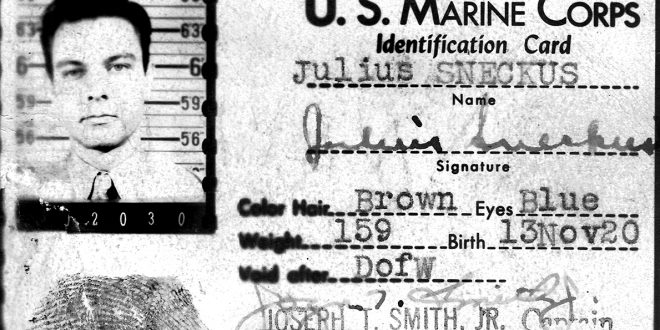Two Brothers Went to War, Only One Came Home Neither Is Forgotten
Sandy Baksys.
Some 80 years ago, Julius and George Sneckus went to fight for their parents’ adopted homeland in World War II. The only children of first-wave Lithuanian immigrants Petronele (Nellie) Matukaite and Jurgis (George) Charles Snieckus, the brothers had that special bond forged, from their earliest age, by straddling two languages and cultures.
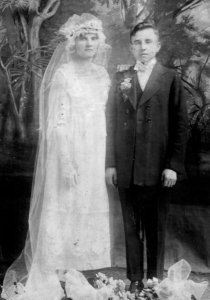
And the Sneckus boys were far from alone. More than 1,100 infants were born to Lithuanian immigrant couples in Springfield, Illinois, between 1909 and 1919. Thousands more were born to southern Italian, “Danube” German, Slovenian, Czech, and Polish immigrants during the same period. And more “immigrant children” like Julius and George were to follow in the 1920s.
All were the product of the largest wave of European immigration the U.S. had ever experienced. And due to its factories and coal mines, the North Side of Springfield where Julius and George Sneckus lived was Springfield’s prime immigrant neighborhood.
During World War I, it was the immigrants, themselves, who had been called to fight for their new country. Records show that Julius and George’s father registered for the U.S.’s first military draft (selective service). Then just over 20 years later, it was the immigrants’ American-born sons whose lives were intruded upon by World War II.
Documents from the Sneckus brother’s war show that Julius and George were part of a “band of brothers” even before they enlisted. The patriotic bravado of their neighborhood boys club, “The Vultures,” probably goes a long way towards explaining why six of its 14 members, including both Sneckus boys, entered the U.S. military soon after high school.
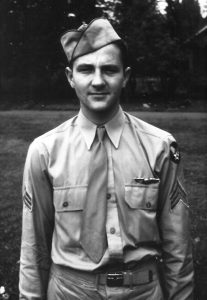
Perhaps the strong patriotism so many of the friends exhibited by enlisting was the “glue” by which youth of many different national backgrounds could prove themselves and bond in their formative years. Perhaps it was how they proved themselves and bonded with their “more American” peers.
One thing we do know: It was for love of “home,” ironically, that so many young men agreed to fight, and possibly die, half-way around the world. And the “home” they fought for was defined by close, lifelong bonds with family and with neighborhoods that were more like an extension of family than any most of us know today.
We Are “The Vultures”
Julius Sneckus was born in 1920, followed by his brother George in 1922. The brothers grew up on semi-rural North Bengel Street in Springfield and probably spoke only or mainly Lithuanian when they entered school.
The brothers received their First Holy Communion together on the same day in 1931 at the newly-built St. Aloysius Catholic Church. Julius graduated in 1939, then George in 1940, from the new Lanphier High School—built, just like their church, to accommodate the burgeoning families of Springfield’s “immigrant” North Side.
Nevertheless, the strongest affiliation the brothers seemed to share, outside of family, was their membership in a self-styled neighborhood boys club called “The Vultures,” starting in 1935.
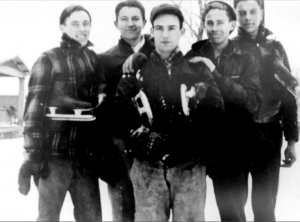
Although other members of the Vultures undoubtedly had brothers, Julius and George were the only siblings in the 14-member group. Markedly taller than George at six-foot-four, Julius’s handle in the group was “Snake,” after the brothers’ Americanized Lithuanian surname, Sneckus. Of course, that made George “Little Snake,” or “Lil Snake.”
A year after graduating from high school, an accomplishment that was especially meaningful in a family where both immigrant parents probably had been illiterate before arriving in the U.S., Julius, the quiet brother, enlisted with the U.S. Marines. The date of his enlistment, December 1940, was a full year before the Japanese attack on Pearl Harbor, although he had to be aware that World War II had already begun in Europe. As the older son, Julius probably saw the military as his chance for a steady job that applied his aptitude for mechanics in an era of still-stubborn post-Depression unemployment. More outgoing and slightly younger George played first violin in the Lanphier High School Orchestra. Sometime after he graduated in 1940, George went to work at Springfield construction machinery giant Allis-Chalmers. It was a good-enough job to allow the 19-year-old to buy his own automobile. The “mechanics” of his purchase might have been a special point of connection with his far-away brother. Or, the car might have represented a form of friendly competition, of brotherly one-upmanship that propelled Julius to be first into the military, George to be first to put a car in the family’s drive.
America’s War Begins
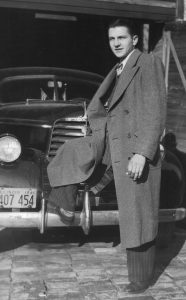
On Dec.7, 1941, the Japanese attacked Pearl Harbor. By September 1942, young George had enlisted in the U.S. military—but not in the Marines like his older brother. Instead, George joined the U.S. Army Air Corps. By October 1942, he was stationed at the Air Corps Technical School at Keesler Field, Biloxi, Mississippi, on the Gulf of Mexico. In December, he was transferred to Lowry Field, Colorado.
Over the next 18 months, George logged 258 hours of aerial combat training as a tail gunner and waist gunner at U.S. airfields as far-flung as Arlington, Texas; Moses Lake, Washington; Wendover Field, Utah; Kearney, Nebraska; and the 393rd Combat Crew Training School at Sioux City, Iowa—before his final U.S. posting at Langley, Virginia. Crew training consisted of navigation, gunnery, bombing, and formation flying (day and night). In March 1944, George was sent to England.
Originally with the Army Air Corps’ 4th Search Attack Squadron, on May 5, 1944, he was transferred to the 8th Air Corps’ 100th Bomb Group at Thorpe Abbotts Airfield in East Anglia, England. George’s transfer probably resulted from the heavy casualties the “Bloody Hundredth” frequently suffered. Thorpe Abbotts was one of 122 British and U.S. airfields in England from which bomber groups were attacking German-occupied Europe in anticipation of the Allied invasion of France on D-Day.
A few months before George joined, the 100th received the first of its two Presidential Unit Citations for staging America’s first daring daylight raid on Berlin.
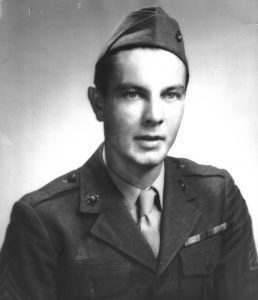
Julius, meanwhile, completed his basic training as a Marine in San Diego in December 1940 and earned his sergeant stripes serving in the U.S. war against Japan in the South Pacific. This included service in British Samoa from August 1, 1942, till November 5, 1943; the Hawaiian Islands from November 25, 1943 till January 22, 1944; the Marshall Islands January 31 till April 7, 1944; and Guadalcanal April 13 to June 3, 1944.
In one of his last, surviving letters home, George celebrated Julius’ promotion to sergeant and wrote that he thought his parents would find Julius “different” when they saw him again. George also wrote, “I sure wish Julie and I could both get furloughs to come home.”
Georgie’s Story
News that the Sneckus parents had received a telegram from the Army reporting their 21-year-old son George missing-in-action was carried in Springfield’s The State Journal-Register newspaper on June 9, 1944. The newspaper reported that U.S. Army Air Corps Staff Sergeant Sneckus had gone missing in “operations over Germany” on May 24 while serving as a waist gunner on a 10-man B-17 Boeing “Flying Fortress” heavy bomber.
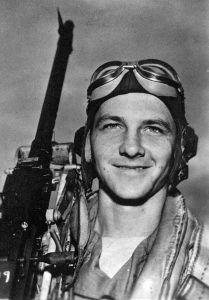
On that fateful morning, George’s bomber, piloted by First Lt. Martin T. Hoskinson of Anchorage, Kentucky, flew out of Thorpe Abbotts Field, headed for a risky daylight raid on Berlin. It was only George’s second mission—and one of the 100th’s “bloodiest.”
Records show that eight of the heavy bombers that day in a huge, two-tiered formation—four of them in George’s squadron–did not return. Patchy information from surviving airmen’s MACR statements and captured German “Dulag” records were available as early as 1945. These indicated that the planes had gone down in what the Germans considered the great Air Battle of Kaltenkirchen (“Die Luftschlacht bei Kaltenkirchen”) in the northernmost region of Germany near Denmark.
During the battle, George’s bomber had crashed to earth in a farmer’s field east of Itzstedt, Germany–only about 200 meters from another B-17 that crashed west of Sufeld, Germany. A translated German “school chronicle” from Itzstedt reported that “a plane with a big noise came down from the clouds and crashed into the earth, exploding and burning with a big cloud of smoke. All the (nine) airmen inside the plane were dead and burned by fire and the 10th lay dead outside, in the field.”
As early as 1946, the American Graves Administration for the European Theatre had learned that the German Air Force had brought the remains of the killed-in-action (KIA) aviators from George’s plane to the South Cemetery in Neumunster, Germany. There, on May 27, 1944, the enemy American airmen were given military honors by the German Air Force and buried in plain wooden caskets with a Protestant minister performing religious rites.
MIA Families Turn to Each Other
Letters from the Army without much additional information arrived at the Sneckus home on July 15 and August 23, 1944. There was also a letter June 22 from the Roman Catholic Chaplain for the 100th Bomb Group assuring Mrs. Nellie Sneckus that George and the other Catholic airmen had been able to receive “General Absolution and Viaticum before taking off on each mission over enemy territory.”
Through the summer and fall after George’s disappearance, his mother Nellie and brother Julius sent letters seeking additional information about what had happened to him. Some of these letters were addressed to the U.S. military and others reached out for any available news from the families of the other men on George’s plane.
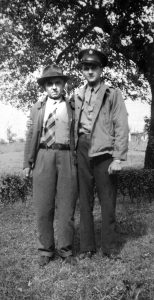
On Sept. 5, 1944, Sgt. Julius Sneckus received an ominous reply from Headquarters, U.S. Army Air Forces: “We have no record which would indicate that your brother is in a hospital.”
On Nov. 4, 1944, the wife of co-pilot Second Lt. Marvin R. Apking of Wynot, Nebraska, advised Nellie Sneckus that the mother of another airman (Jerome Miller) had received word that her son was dead. “I still feel sure that our boys are safe somewhere and I believe our prayers will be answered,” Mrs. Apking wrote.
Then, just after the May 1945 V-E (Victory in Europe) Day, George’s parents received a letter from the Army declaring Staff Sergeant Sneckus dead “in view of the fact that 12 months have expired without…evidence to support a continued presumption of survival.” The declaration, the Army said, was necessary for “the termination of pay and allowances, settlement of accounts and payment of death gratuities.”
Later in 1945, the Army issued George’s parents $791 of his back pay. A death gratuity of $500 was mailed to each of George’s parents. Then, news of a $10,000 insurance death benefit arrived from the Veteran’s Administration, to be paid Mr. and Mrs. Sneckus at the rate of $53.60 per month.
At the close of the War Department’s letter in May 1945 declaring George dead, Maj. Gen. J. A. Ulio wrote, “I regret the necessity for this message but trust that the ending of a long period of uncertainty may give at least some small measure of consolation.”
Equally important, with the defeat of Germany, the Army finally could begin recovering information and the remains of its missing soldiers from former enemy territory.
Identifying the ‘Unknown’ Airman
On May 22, 1946, a special U.S. military reburial team recovered the bodies from Neumunster, Germany and extensively interviewed local witnesses about the events of late May 1944. One of the ten bodies (Jerome Miller) was identified immediately. Nine others were difficult to identify due to their condition and the unauthorized removal of dog tags at the time of death.
The unidentified remains were taken to an Army “overseas scientific laboratory” to be examined by “qualified technicians.” In that lab, George’s remains were tentatively identified based on the “favorable comparison of tooth charts.” Then, all of the bodies were reburied on June 3, 1946, at the Ardennes American Cemetery in Neupre (formerly Neuville-en-Condroz), Belgium. George was buried under a cross as “Unknown X-955” pending further investigation by Army analysts.
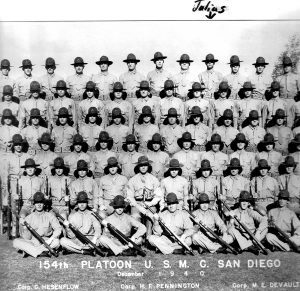
On Sept 10, 1946, the Army issued George’s official Battle Casualty Report, listing him as KIA. George’s “Report of Burial” at Ardennes was issued Dec. 4, 1946. But the work of positive identification continued.
On Jan. 23, 1947, a commander of the Army’s Graves Administration wrote to the commanders of Keesling Field in Mississippi, Lowry Field in Colorado, and Langley Field, Virginia, requesting any available dental records.
That the identification process was emotionally fraught for George’s family is indicated by the many documents that they received and preserved. In the first months after the declaration of George’s death, their lost hopes for his survival were replaced by hope of recognizing his body even when the Army apparently couldn’t. Yet their desire to see the George they knew again, combined with the fear that he was now unrecognizable, complicated their decision about whether to bring George’s remains home.
In a hand-written letter to the Army dated Nov. 23, 1946, George’s mother Nellie asked, “If the body is brought back home, is there any way we can positively identify him as our son?” But as the process of identification wore on and the Sneckus family received more detailed information about the state of George’s remains, their last hope of seeing him, even in death, faded.
‘Gold Star’ Parents
Finally, in November 1948, George’s parents received a letter from Lt. Col. T. H. Metz of the Graves Registration Memorial Division notifying them that their son had been positively identified by forensic technicians utilizing dental records. The letter gently asked them to “review for themselves” the Army’s facts and reasoning.
“It is the opinion of our identification analysts that this deceased is your son. However,” the letter added, “it is the policy in a case of this nature to present the facts to the next of kin before making a final determination.”
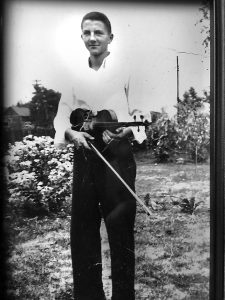
By January 1949, George’s parents had notified the Army that they accepted their son’s identification and gave their approval for the inscription on the white marble cross in Belgium to be changed from “Unknown X-955” to S/Sgt. George Sneckus. That same month, the Army issued one “Gold Star” lapel pin and one “Gold Star” button “engraved with the initials GS” to George’s parents. They never requested or received any of their son’s war medals.
Personal effects mentioned in several documents also probably were returned to Nellie and George Charles, including George’s writing materials, airman’s wings, shaving kit, and original copy of his power of attorney.
Mysteriously, records do not show what happened to a “worn and water-damaged” photo reportedly recovered with George’s body from Germany. The photo was received by the Army’s Quartermaster General in 1947 and was still being held by that office, under George’s name, in 1949. It is not known who was in the photo or if it played any role in identifying George’s remains.
What Really Brought Down George’s Plane?
Questions about how, exactly, their young man died never go away for any Gold Star parents. And when that need to know is not satisfied, it can become a mystery binding together the generations. As it turns out, it took almost 60 years—and the Internet – for the mystery surrounding the crash of George’s plane to finally be solved by a family member he had never met: his brother Julius’s daughter Teresa.
Julius Sneckus was honorably discharged from the Marines in September 1945, went back home, and gained certification as a union carpenter. He married in 1948, used his carpentry skills to build a home two doors down from his parents, and became a parent, himself, in 1953.
Teresa Gregoire (nee: Sneckus) of Springfield never knew her father’s only brother. “When I was a little girl in the late 1950s, during the summer months, I would often see my grandmother Nellie sitting for hours in solitude in her backyard. Her tulip chair facing west, she would watch the sunset while my grandfather tended to his very large vegetable garden,” Teresa recalls. “I believe she suffered from depression, which was probably true of so many parents who lost their sons and daughters in World War II.”
Teresa still treasures George’s high school violin, etched with the name of his boys’ club the “Vultures,” along with other relics of her uncle’s life. Another of those is a framed portrait taken of the young airman with his 50-caliber Browning machine gun. And she still remembers the framed portrait of George with his airman’s wings hanging above her grandparents’ television until Nellie’s death in 1964 and George Charles’s death in 1965.
Teresa grew up, married, and had two sons of her own, Ryan and Nathan. Then one day in the late 1990s, when her sons were teenagers, a friend of Teresa’s mother, U.S. Army veteran Jim Graff of Middleton, Ill., who had fought in the famous Battle of the Bulge, suggested that the family should have George’s military medals.
Very active in veteran-related events honoring the lives of his fallen comrades, Jim provided Teresa with the address and information needed to claim George’s Purple Heart, WWII Victory Medal, and European-African-Middle Eastern Campaign Medal. More importantly, Graff introduced Teresa to an extremely helpful and thoughtful contact in England, Robert (Bob) Watkins.
German vs. American Information
Amazingly, Robert tracked down a lead from a German veteran providing new information that conflicted with official records describing George’s death. American records state that a thousand-pound bomb was accidentally dropped on George’s plane from a B-17 flying above. This was, unfortunately, not an uncommon accident in formations that included hundreds of B-17s. However, German records indicate something different happened.
They describe George’s bomber as the lead plane in the second tier of a B-17 formation. Though armed with ten 50-caliber machine guns and able to sustain considerable damage and keep flying, the B-17 lumbering giants were easy targets for Luftwaffe fighters.
In theory, a bomber group’s survival depended on flying in tiered “box” formations that massed the B-17s’ guns against German Me-109 and Fw-190 fighters. For their part, German fighter pilots typically attempted to break the B-17 formation by flying into it from the front, where less defensive firepower could be directed. Such frontal assaults could force the B-17 pilots into evasive maneuvers. And, once out of formation, the more vulnerable individual bombers could be shot down.
In the case of George’s ill-fated mission, it was reported that Fw-190 German pilot First Lt. Konig, a wing commander who was very experienced in daytime flying, was cruising at an altitude of about 6,000 meters when “the first B-17 appeared in a shadowy, milky haze.”
Konig and the other German fighter aircraft made many passes, but due to the haze from cirrus clouds and bomber contrails, could still not judge very precisely their distance from the American B-17s. At some point, Konig, who had only one eye and was returning from a night-time mission, flew head-on into George’s B-17 while making a close frontal pass. Konig’s plane also could have been shot on approach. But poor visibility that day and Konig’s lack of depth perception almost certainly played a role. As the German fighter approached, neither pilot veered.
A wing of Konig’s plane was seen falling off as he went down, and German reports later described a downed Boeing “Flying Fortress” near Itzstedt that was “completely destroyed.”
60 Years After the War: Pilgrimage to George’s Grave
Using internet links provided by Bob Watkins, Teresa located George’s grave in Belgium. Then in August 2001, Teresa, her mother Josephine, and three other family members crossed the Atlantic to visit Thorpe Abbotts Air Force Base and George’s final resting place.
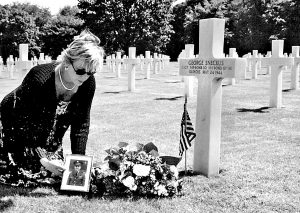
During her research, Teresa had been contacted by the daughters of two crewmen on George’s plane. (One was the daughter of Mrs. Martin Apking, whom George’s mother Nellie had exchanged letters with almost 60 years earlier.) Born while the men were at war, neither daughter had ever met her father. Teresa promised to decorate both men’s graves and take photos.
Thorpe Abbotts is where George was stationed for 2-3 weeks prior to his fatal mission. Complete with a memorial museum, a foundation and a website, the former air base has been restored to honor the 100th Bomb Group and all the airmen of the 8th Air Force. While there, Teresa and her mother envisioned a young George living, training and taking off in his heavily ladened bomber from the main runway, just 30 minutes by air from targets on the continent.
Later, at the Ardennes American Cemetery in Neupre, Belgium, the U.S. visitors were humbled by what they saw: more than 5,000 white marble crosses in perfect formation, one for each fallen soldier. Before leaving on her trip, Teresa had filled a container with soil from George’s boyhood backyard on North Bengel Street in Springfield to sprinkle on his grave. Because George had never been able to return home, she wanted to bring his “home” to him.
Teresa also left a fragment of the Thorpe Abbotts’ runway, given to her by the base’s caretaker, next to George’s cross. The family then placed large bouquets of fresh flowers on the graves of George and his two brothers-in-arms, said prayers, and sang patriotic songs. Finally, the graves of the fallen had been visited and decorated by people from home.
Facts Confirmed by Eyewitness
Once home, Teresa decided to contact the Thorpe Abbotts’ online discussion board and posted the following: “Researching my uncle’s death, I discovered that the German and American records present conflicting accounts of this air battle. Can anyone tell me which story is accurate?”
Within a few minutes she received a response from a Robert Black, who had been a radioman/gunner on the Lt. Clarke T. Johnson B-17 shot down during the same battle, crashing 200 meters from the Lt. Martin T. Hoskinson plane that George was on.
One of only three survivors from the four planes lost from George’s squadron, Robert confirmed that it had happened as German records said. “I was in the plane behind your uncle’s and witnessed the collision.”
Having two sons of her own, both now older than George when he died, Teresa says she can’t imagine how his mother (her grandmother) Nellie must have suffered. “My father was in the Marines, fighting in the Pacific at the same time George was fighting in Europe. I sometimes wonder if he had lived and grown older along with my father, they would have shared their war stories with us,” she muses. Although many veterans never discussed combat with their children, it might have been extra hard for Julius due to the guilt of surviving his only brother.
Two Fates Joined in Memory
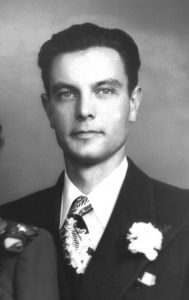
George Sneckus crashed to earth in a bomber that itself, become a bomb, dying a hero but leaving his parents without the chance even to see his body one last time.
Julius Sneckus came home to become a husband, father, and grandfather; he died of cancer 50 years after his brother George, in 1994.
However, both men are forever joined in the memory of Julius’s descendants. Niece Teresa, who vowed during her first visit to George’s grave to return, traveled back to Belgium in 2018, this time with her husband Ron and their two grown sons. “I thought it was our best chance to honor George as a family,” she explains.
Teresa’s sons Ryan and Nathan were starting families of their own, making Julius a great-grandfather and George a great-great uncle. And so, this second visit to Ardennes was Teresa’s way of passing on George’s memory to the next generation.
The ceremony at George’s grave this time included burying a shell casing there from the 21-gun salute at Julius’s burial in Camp Butler National Cemetery near Springfield. During her first visit, Teresa had sprinkled some soil from the Sneckus family backyard on George’s grave. This time she took back some soil from George’s grave for his brother Julius’s.
“As we were leaving George’s grave, my son Ryan kind of leaned over and kissed the top of his cross. Then Nathan did the same thing, and we all did the same, kind of to say ‘Good-bye, George, and we’ll be back.’”
Snieckus Family Background
George’s father Jurgis Charles Snieckus (born 1894 to Simon Snieckus and Elzbieta Maruskite) emigrated from Sulvakija, Lithuania, in 1913. He was working in a knitting factory in Rockford, Illinois, in 1919 when he married Vilnius, Lithuania-born Chicago resident Petronele (born 1891 to Michael Matukas or Matukatus and Petronele Lukosute). The couple lived in the manufacturing and coal-mining hub of Springfield, Ill., in the mid-to-late 1920s after the birth of son Julius in Chicago. George Charles had been certified as a coal miner in 1923 in LaSalle County, Ill., and he worked as a coal miner in Springfield while Julius and George were growing up.
Their War in Letters
To adapt to the shock of being homeboys so far away from home for such long periods of time, the far-flung “Vultures” of Northside Springfield became big-time letter-writers. Almost every surviving letter from George mentions his brother “Julie” or one of their “Vulture” pals also in the service.
But letters often took weeks or months to arrive. That, plus military secrecy, made it hard for anxious parents to follow their soldier’s narrative, or even just know how their son was doing since his last, belated letter.
So, in one of his pencil-written missives to “Mom and Pop,” George Sneckus advises his parents that a Chicago comrade approaching discharge is also going to write to them. Any buddy who had been with a son in harm’s way and could report on him firsthand was, effectively, no longer a stranger and more like a son, himself, to worried parents.
Some of the “Vultures,” in and out of service, even took it upon themselves to write to each other’s parents with info they had from each other that a parent might not yet know. Parents returned the favor by writing to their son’s friends.
In an April 3, 1945 letter, the father of killed-in-action (KIA) “Vulture” Charles Cardoni writes to Julius Sneckus to thank him for his condolences. Mr. Cardoni also reports gleaning from Julius’ letter the fact that his son Charlie had been in the hospital in Belgium before he died—something that the bereaved father, hungry for any scrap of information, did not know.
“When Charlie wrote to us, he didn’t mention that he was in the hospital. When did you get his last letter?” the father implores. “We are sure hoping it (Charlie’s death) is a mistake because they (the Armed Forces) have made them before.”
The bereaved father reveals that “Charlie was in so many battles I believe he was getting too tired of it all. He said anybody who saw him now would have a hard time deciding who was the older, his dad or him…”
Mr. Cardoni also refers to previous wounds Charlie had suffered, causing the father to write to the Army requesting a furlough for his son—without success. The implication is that maybe if leave had been granted, Charlie might still be alive.
Finally, Mr. Cardoni affectionately mentions Julius’ own missing-in-action (MIA) brother George.
“You know, Julie, Charlie felt so bad about Georgie. He wrote in every letter asking if your parents had heard any more about him.”
Julius Sneckus was stationed at the Marine Barracks at Klamath Falls, Oregon, when he read those lines. The older brother had already served as a mechanic and driver for Marine brass all over the South Pacific. He had been in Guadalcanal in early June 1944 when his parents received the telegram that no parent ever wants to receive from the U.S. Army.
 DRAUGAS NEWS Lithuanian World Wide News in English
DRAUGAS NEWS Lithuanian World Wide News in English
